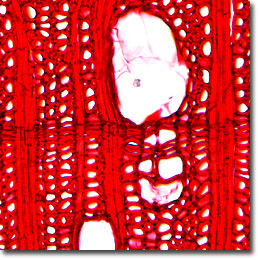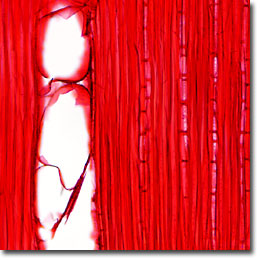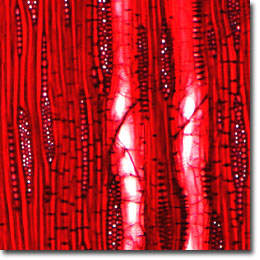The Black Walnut
Also known as the Persian Walnut and the Eastern Black Walnut, the Black Walnut (Juglans nigra) is a hardwood tree that grows in many parts of North America, as well as throughout Europe. The sapwood is whitish to yellowish brown, but the heartwood is a coveted light brown to rich chocolate. Often, the sapwood of this valuable tree is darkened to match the heartwood by steaming or staining to produce the finest domestic cabinet wood.

Cross Section

Radial Section

Tangential Section
The roots of the black walnut produce a substance known as juglone (5-hydroxy-alpha-napthaquinone). This biochemical is toxic to many plants such as the tomato, potato, black and blue berries, and other plants that may grow within a 50 to 60 foot radius of the trunk. Not all plants are sensitive to juglone and many trees, vines, shrubs, and flowers will thrive in close proximity to a black walnut tree. Landscapers should carefully consider the planting site for the black walnut rootstock if other plants are going to reside in close proximity. The tree grows to heights as tall as 150 feet with a 6-foot trunk diameter, but a majority of the trees never reach this size. Propagation is primarily by seed with the black walnut and by grafting with the Persian (or English) walnut, usually in a fertile, well drained, but still moist soil.
Black walnut wood is used for plywood faces in the manufacture of furniture, in cabinetwork, and for interior paneling and fine gunstocks. The lumber is used principally for furniture, especially for tables and desks. Other uses include fixtures, caskets and coffins, cabinets, and piano cases. Black walnut wood is desirable because of its ability to stand hard usage, with good working qualities and a pleasing appearance.
Microscopic examination of iron-alum hematoxylin and safranin stained thin sections (see the digital images presented above) reveals a semi-ringed porous wood having simple perforation plates and fairly abundant tyloses. The tissue displays few vessels, with 10-16 micron inter-vessel pits that are orbicular to oval or angular (through crowding) in shape. Fiber tracheids are moderately thick-walled and medium to very coarse in texture. The rays are 1 to 5 seriate and heterocellular to homocellular.